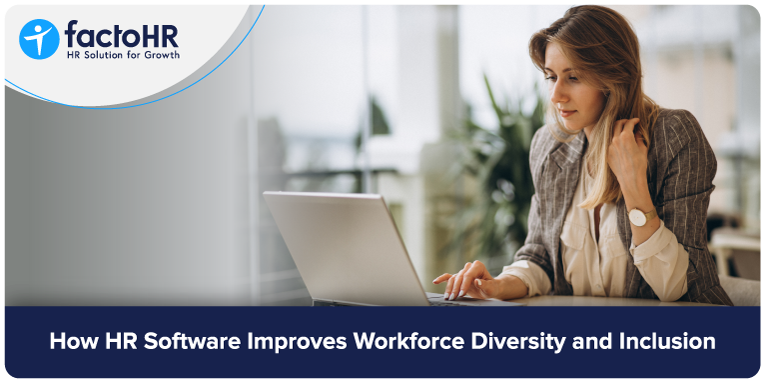How HR Software Improves Workforce Diversity and Inclusion

Table of Contents
Current business conditions and the environment highlight that diversity and inclusion are no longer optional. They are essential to an organization’s success. Organizations that embrace diversity and inclusion in the workplace have been scientifically proven to be more innovative and effective.
As businesses prioritize diversity and inclusion, HR software is becoming a powerful tool for progress. It gives companies the insights they need to plan and act purposefully, creating a more inclusive and fair organization.
When talented professionals implement diversity and inclusion as part of their organization’s HR systems, it creates a practical foundation for meaningful change. This approach helps transform D&I from a strategic vision into a practical reality through technology.
This blog will discuss how HR solutions software can bring positive organizational change by promoting workforce diversity and inclusion.

Challenges to Diversity and Inclusion Without HR Software
D&I is a crucial and complex process of shaping a workplace culture that values individual differences and shared attributes. Without the right HR software, organizations can encounter challenges that impede growth, complicating efforts to create a genuinely diverse and inclusive culture.
1. Unconscious Bias in Hiring Practices
Unconscious bias refers to the tendency in hiring and selection processes to favor candidates based on characteristics like race, gender, or color. If an organization neglects to use HR software, it might inadvertently preserve ethnic uniformity. This practice can limit the development of new ideas and creativity within the workplace.
2. Inadequate Tracking of Diversity Metrics
Currently, many organizations find it hard to assess and evaluate D&I efforts. Achieving cultural diversity and inclusion in the workplace can be challenging without transparent metrics such as hiring ratios, ethnicity statistics, and employee turnover data to monitor progress and ensure alignment with company policies. This may cause the company to miss opportunities to adopt practices that honor diverse cultures and support the growth of culturally diverse organizations.
3. Difficulty in Employee Engagement and Retention
The challenge lies in attracting and retaining talent from diverse backgrounds, where organizations often lack effective strategies. When organizations don’t have an HR platform to support feedback and engagement tools, they limit themselves in terms of employee satisfaction. If organizations do not grasp these employee experiences and fail to address their needs, they risk losing top talent, leading to higher employee turnover rates and diminished workplace morale.
4. Limited Leadership Engagement
There is no doubt that when building an inclusive work culture, leadership engagement is essential for driving meaningful and lasting change. However, if D&I data is not integrated into HR software and properly analyzed, executives may miss key issues or opportunities for growth in this area. In such situations, the executive might stay unaware of the issue. This may lead to insufficient funding, hindering D&I initiatives, causing progress delays, and fostering a negative view of workplace diversity.
5. Fragmented Learning and Development Opportunities
Cultural diversity in the workplace should be supported with ongoing, personalized training and programs that meet each employee’s needs. Neglected skill gaps and training, despite appropriate software, may hinder organizations that do not have a solid HR system in place. As a result, employees may feel unsupported in their growth, leading to a perception that diversity and inclusion are not valued in the workplace.

How HR Software Enables Diversity and Inclusion?
Using HR software helps organizations improve cultural diversity and inclusion. It does this by making processes more efficient, reducing bias, and providing useful data. Here are some ways HR software improves diversity and inclusion in the workforce.
Bias-Free Recruitment with Structured Workflows
The recruitment process has many steps, and HR software helps manage them better by minimizing human bias. Additional elements like job analysis, recruitment and selection criteria, and interview questions show that the software assesses each candidate fairly. This leads to a wider hiring pool and an appropriate selection process that avoids discrimination against applicants.
Analytics to Monitor D & I Metrics
Regarding diversity and inclusion, the HR software generates relevant reports and statistics that enable organizations to monitor their progress. The measurement of D&I involves tracking various indicators such as the number of employees of diverse backgrounds across departments, the rates at which such employees get promoted, and overall satisfaction. It makes the hiring process easier and simpler to manage, ensures long-term efficiency, and allows adjustments based on changing workforce needs.
Inclusive Onboarding for Every Employee
HR software facilitates an effective onboarding experience for new employees, regardless of their role or level. This involves individualized orientation processes, tailored learning media and materials, and clear communication of company values and expectations. From the beginning, strong employee relationships help new hires feel welcomed and included, making it easier to handle workplace diversity.
Equal Learning and Growth Opportunities
As mentioned above, HR software helps ensure all employees receive equal learning and development opportunities. HR software improves workforce diversity and inclusion through skills assessment, training management, resource allocation, and employee development monitoring. In this way, all employees of an organization receive an equal opportunity to develop themselves and contribute positively to the company.
Fair Performance Management
Effective performance management is essential for every organization and achievable only with quality HR software. Consequently, reviews are simplified, objectives are clarified, and feedback is meaningful; this ensures employees are rewarded equitably and without bias. This benefits the organization by enhancing employee engagement, reducing turnover, and supporting fair workplace practices that align with business goals.

What to Look for in HR Software to Support D & I
Without effective HR software, a workplace cannot achieve proper workforce diversity management and inclusiveness. So it’s essential to be mindful when selecting an appropriate HR software. Below are some features to look for: Bias-Free Candidate Sourcing and Screening:
The software needs built-in mechanisms to reduce hiring bias, such as resume parsing automation, which strips away identifying information, and skill-based algorithm selection, which ignores demographic factors. The application should also embrace standardized interview questions as part of its support system.
Diverse Candidate Pools
The software should enable outreach to recruiting candidates from multiple backgrounds through organizational connections with minority groups and different job search platforms.
Data Collection and Reporting on Demographics
The software platform should offer tools to collect employee demographic details from various candidates via confidential data processing. It should also offer analytical capabilities for discovering departmental demographic gaps and present such findings in data formats suitable for decision-making.
Inclusive Communication Tools
The software should facilitate clear and open communication among diverse employees by providing translation options and enabling them to tailor their messages for various cultural contexts.
Equity-Focused Performance Management
Performance management software should deliver unbiased evaluation standards and metrics alongside skill-oriented feedback platforms for practical performance assessment. Organizations must monitor promotion rates and development possibilities for each demographic group.
Thus, the core HR module helps to build a diverse and inclusive workplace by deploying these features while advancing fairness and beneficial results for every employee. Therefore, looking for these essential features is advisable before selecting software for your company.

Conclusion
Nowadays, organizations need to embrace diversity and inclusion, as they are key to success. These goals are well supported by HR software, as it significantly aids in decision-making, minimizes biases in the hiring process, and fosters employee engagement. With tools like factoHR, organizations can attract top talent while ensuring every employee feels valued and included. HR software helps build a diverse and inclusive culture, driving organizational success. Use this blog as a guide to choose the right HR software to improve workforce diversity and inclusion.
Grow your business with factoHR today
Focus on the significant decision-making tasks, transfer all your common repetitive HR tasks to factoHR and see the things falling into their place.

© 2025 Copyright factoHR


